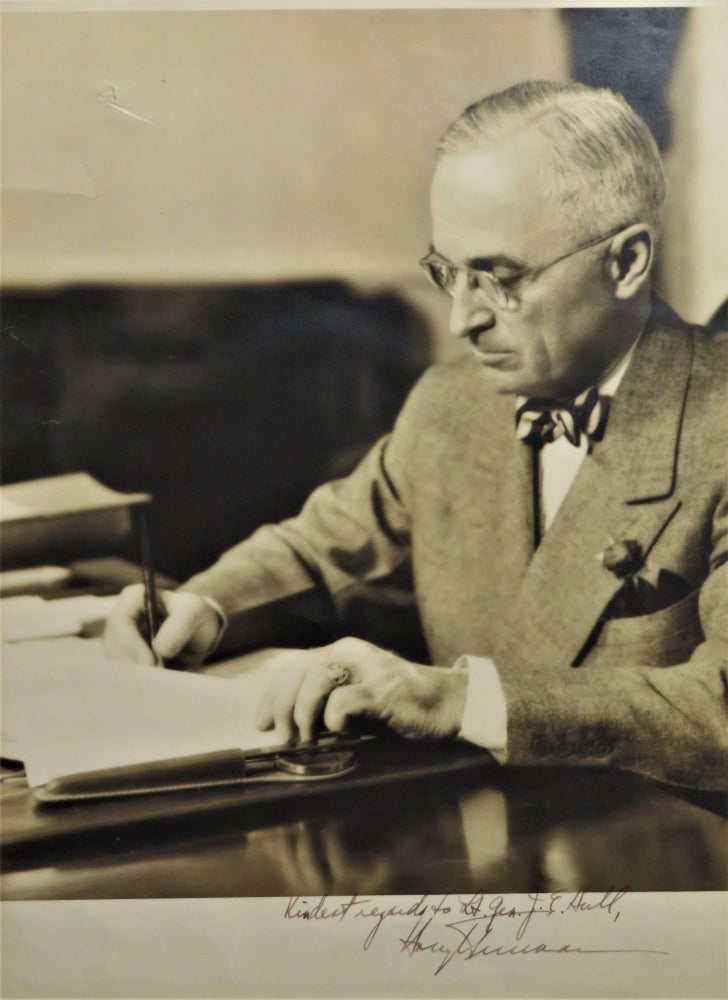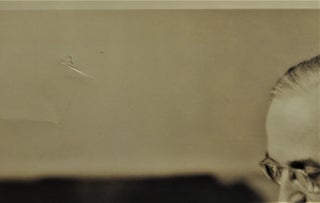A large, signed photographic portrait of President Harry S. Truman inscribed to one of his Second World War Generals
circa 1945. Photograph. This large, gelatin silver photographic portrait of President Harry S. Truman is inscribed by him in two lines “Kindest regards to Lt. Gen. J.E. Hull, | Harry S. Truman”. John E. Hull (1895-1975) spent a career in the U.S. Army, serving in both World Wars, ending the Second as a Lieutenant General assigned to the Army’s Operations Division. Throughout Truman’s presidency, Hull’s career alternated between Pentagon and Pacific commands. His final assignments before retiring in the early years of the Eisenhower administration included Commander-in-Chief, United Nations Command and Commander-in-Chief, United States Army Forces Far East.
This photograph measures a substantial 10.75 x 14.75 inches (27.3 x 37.46 cm) printed on thick, matte paper. Truman is seated at a desk signing documents, characteristically dapper with a flower in his lapel and a striped bowtie, sternly attentive to the document and his signature thereon. Integral margins at the top and bottom measure .375 and 1.625 inches (.95 x 4.13 cm), both bottom margin bearing Truman’s inscription and signature, which only slightly intrudes into the lower portion of the image. Condition is very good. The image is clean with no soiling, only mild toning, and little wear to extremities. The chief defect that prevents our grading it as “near fine” or better is a small, visually unobtrusive puncture in the blank background at the upper left corner of the image, repaired on the verso with a small piece of what appears to be archival tape.
Harry S. Truman (1884-1972) assumed the presidency in 1944, succeeding Franklin D. Roosevelt. His predecessor, FDR, had been elected an unprecedented four consecutive times before his death on 12 April, 1945, only a few months into his fourth term. Truman had only been FDR’s Vice President during that brief fourth and final term – and during the 82 days Truman held that position, he had almost no contact with FDR; Truman had been selected as a compromise candidate, an intentionally neutral choice that would appease both different factions of the Democratic Party.
Truman was pejoratively called a ‘haberdasher’ by detractors because of his failed clothing store business, which many perceived as an extension of his political character, considering him distinctly lacking in presidential qualities and gravitas. Any successor to FDR might have been plagued by unflattering comparisons, but Truman, chosen precisely for his lack of ability to draw attention and excite controversy, was especially vulnerable.Nonetheless, neither Truman nor his presidency proved inconsequential. Truman neither avoided crucial decisions nor made them lightly. “On such matters as the atomic bomb, the decision to intervene in Korea, and the dismissal of General Douglas MacArthur, he engaged in wide and time-consuming consultations before acting.” (ANB). Beginning with critical economic aid for postwar Greece and Turkey, the “Truman Doctrine”, intended to forestall the spread of communism, became a foundational American Cold War policy. Aid championed by Truman most prominently included the Marshall Plan, which helped to sustain and stimulate postwar western Europe.
Truman inevitably labored under the long political shadow cast by his predecessor, but “By mid-1948 it was manifest that Truman’s foreign policy had historic implications and was likely to be successful. Moreover, he had moved far toward rebuilding the Democratic presidential coalition and was in a position to make inaction on his domestic program a campaign issue. Still, few observers thought Truman could win [re]election in his own right.” (AND). Therefore, when Truman was reelected in 1948, beating Republican Governor Thomas E. Dewey, it was considered one of the biggest election upsets in history, and afforded Truman the validation of a presidency contested and won rather than merely inherited. Item #006150
Price: $900.00



